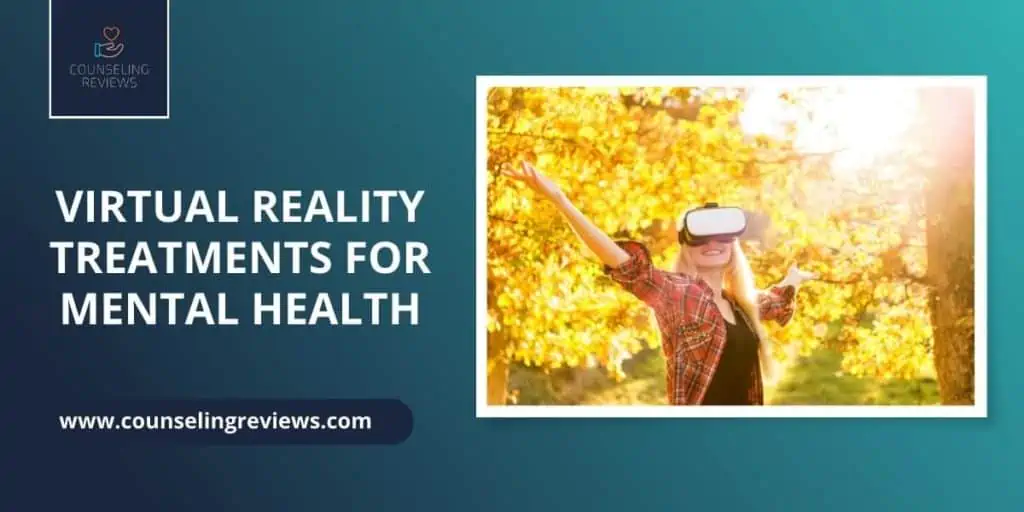We write our honest reviews but this page may contain affiliate links, with some of the partners mentioned, to support this website. Read more here
Patients with psychiatric disorders can benefit from innovative technology and the emergence of virtual reality.
On the morning of June 21st, back in 1995, the New York Times published promising news on the success achieved in acrophobia with virtual reality (VR).
The article titled “Virtual Reality Conquers Fear of Heights” shared the success story of Mr. Klock, who carried the morbid fear of heights from the age of 10 and was able to ride a real glass elevator.
Mr. Klock was part of the first-ever controlled study that was published in the American Journal of Psychiatry.
With a head-mounted display sitting in a therapy room, he experienced being on a 20-story balcony, traversing narrow bridges or glass elevators.
Together with the clinical psychologist Barbara Rothbaum, after weekly therapeutic sessions for seven weeks period, accompanied by 12 people that shared the experience, Mr. Klock’s fear was successfully treated with a VR setup.
The Evolution of VR as a Treatment Approach
VR treatment helped people with anxiety and avoidance of height and became a whole new treatment approach.
But the history of VR development began far before 1995.
The roots of using VR for treatment date back to 1957 with the idea of cinematographer Morton Heilig to stimulate all the senses of the audience to effectively get into the story.
In 1960, he built Sensorama, however, was not interactive and considered entertainment with no expectations for clinical usage.
Back in 1961, Philco Corporation developed the first head-mounted display, (video screen and tracking system linked to a camera system) with the intention to be used in dangerous situations.
The next milestone for VR development was using VR to confront patients with visualization of the triggers. Rothbaum experimented and used VR to define the environment, control it, and grade exposure to stimuli.
Today, several decades after VR’s pioneering steps in medicine, there are dozens of published studies that prove the effective utilization of VR in mental health treatment.
The Role of VR in Treating Mental Health Issues
Medical professionals put a lot of effort into researching and exploring VR abilities to treat anxiety disorder, depression, panic disorder, pain, addiction, PTSD, specific phobias, panic disorder, and many more.
VR can be used for the treatment of addictions in conjunction with cognitive behavior medications.
VR replicates the traumatic event with the incidence of addiction behavior -this helps clinicians identify the way a patient reacts to devise appropriate therapy.
Some of the other uses of VR include treatment for PTSD, i.e., a mood disorder or personality disorder by exposing patients to the source of the disorder. With exposure and relaxation therapy, patients can gradually adapt to environmental stressors.
It usually takes more than ten years for an experimental treatment to become available for all patients that are in need of suitable treatment.
Overcoming Challenges and Expanding VR Treatment
Although VR became affordable, however, clinicians have ethical concerns with its wide and regular therapeutic implementation.
Efficacy, safety, and reproducibility need to be published in peer-reviewed journals. When it comes to wide dissemination, it takes time for VR to be accepted as a standalone instead of an add-on option.
Secondly, its technique required skills that therapists need to build. Moreover, patients with mood disorders are keen on traditional therapy, so are reluctant to try new ones.
Daniel Freeman and his team work on overcoming the barrier and the need for a real-time presence of a therapist.
Their innovation in agoraphobia treatment with automated cognitive therapy, named as gameChange, is beneficial for patients that are not able to leave their homes without a company.
With the guidance of the virtual coach, patients can navigate real-life situations to overcome physical symptoms of the phobia.
Results of the study suggest that Yes, virtual reality therapy can be used for children, but it should be done with proper consideration and supervision. Virtual reality therapy for children has shown promising results in treating various mental health conditions, including anxiety disorders, phobias, ADHD, and autism spectrum disorders. However, it is important to ensure that the content and experiences are age-appropriate, tailored to the child’s specific needs, and conducted under the guidance of trained professionals. reduces anxiety and distress in everyday situations and talk therapy would be most beneficial for patients with the most severe mental health symptoms.
The Future of VR in Mental Health Treatment
While more challenges await a wider implementation of VR, evidence-based data and unsatisfactory results of existing treatment in some patients are sufficient enough for VR treatment to be offered to a niche of patients with medical condition that could improve their mental and physical health.
Focusing on improving the treatment of mental and emotional disorders, and health by using VR, Rizzo found it practical to use VR for the training of clinicians.
He designed virtual patients suffering from serious mental disorders and physical health problems that were previously monitored by real-life health professionals – such a practice can extend the skills of the practitioners.
However, the concern Rizzo pointed out references unethical collection of data.
In 2004, Rizzo found post-traumatic stress disorder (PTSD) as another field of interest for research.
Together with Rothbaum, Rizzo created a virtual environment reminiscing Iraq and Afghanistan to mimic veterans with the experiences they had during the war.
Clinicians can then adjust content and scenarios as part of traditional therapy; this system was upgraded into BRAVEMIND and adopted as the treatment for PTSD in victims of sexual trauma.
Its implementation could be broadened to new target groups such as firefighters, and first-responders providing medical care during the Covid-19 crisis.
VR in PTSD Treatment and Pain Management
What Rizzo is aiming for is to adjust BRAVEMIND for diagnostic and preventive purposes.
BRAVEMIND is implemented in 15 out of 137 facilities of the United States Department of Veterans Affairs; VR treatments are mostly implemented in large hospitals and centers that specialize in the issue of PTSD.
VR treatment implementation was deemed beneficial for veterans with acute and chronic pain, as well as pronounced stress and anxiety.
Caitlin Rawling and her team used an immersive head-mounted display for 10-30 minutes with autonomously chosen virtual environments, thus measuring the level of pain after surgery and anxiety.
The results of this study showed a 12% decrease in pain intensity and a whopping 92% of anxiety reduction. VR showed to be a viable treatment option for veterans to improve pain management and reduce anxiety.
Personal Success Story: Deborah Judge
Another story of successful VR treatment is the one of Deborah Judge, a veteran of the U.S. Air Force. Her story begins back in 2001 when a drunk driver hit her and she ended up undergoing several surgeries.
She suffered from a rare and painful spinal cord disorder and had anxiety caused by PTSD.
With this new technology, she succeeded to alleviate the back pain and use fewer medications, but also overcoming her social anxiety disorder.
Deborah found VR as most effective compared to various medications, acupuncture, and other therapies.
“In a few minutes, I’m in whatever world I want to be in—which sounds crazy, but it allows me to escape from the realities of my everyday daily life,” Deborah states. “And that, to me, is worth everything.”
Recognition of VR as a Valuable Tool
Given the many perks of using VR for the treatment of serious mental illness and other mental health conditions, more and more facilities and medical professionals credit VR as a priceless tool for their success stories.
VR’s effectiveness in treating mental health conditions has gained recognition among facilities and medical professionals. As success stories continue to emerge, the value of VR as a therapeutic tool for mental illnesses becomes increasingly apparent. Its ability to provide immersive and personalized experiences offers hope and possibilities for transforming the field of both mental illness and health treatment.
Conclusion
Virtual reality (VR) has emerged as a promising tool for the treatment of mental health issues. With its ability to create immersive and personalized experiences, VR offers innovative approaches to address conditions such as anxiety, depression, PTSD, and phobias. Numerous studies have demonstrated its efficacy in reducing symptoms, managing pain, and improving overall well-being.
While challenges remain in terms of widespread implementation and acceptance, the growing recognition of VR’s value among medical professionals highlights its potential as a transformative force in mental health treatment.
FAQs
The duration of a typical virtual reality therapy session can vary depending on the individual and the specific treatment protocol. Generally, sessions can range from 20 minutes to an hour. The length of the session is determined based on factors such as the nature of the serious, mental disorder, illness or health condition being treated, the goals of therapy, and the individual’s tolerance and engagement with the virtual reality experience.
Virtual reality therapy has shown promising effectiveness compared to traditional treatment approaches in certain cases. Studies have demonstrated its efficacy in reducing symptoms and improving outcomes for various types of mental- health disorders and conditions, including anxiety disorders, PTSD, phobias, and pain management. VR therapy offers immersive and controlled environments that can provide targeted exposure and simulation, facilitating therapeutic interventions. While more research is needed, virtual reality therapy has the potential to enhance traditional treatment methods and provide new avenues for personalized and engaging interventions.
Yes, virtual reality therapy can be used for children, but it should be done with proper consideration and supervision. Virtual reality therapy for children has shown promising results in treating various mental health conditions, including anxiety disorders, phobias, ADHD, and autism spectrum disorders. However, it is important to ensure that the content and experiences are age-appropriate, tailored to the child’s specific needs, and conducted under the guidance of trained professionals.
Currently residing in Arizona, John shares his home with two beloved pets - a very cute dog and a cat. Although they don't always see eye-to-eye, John's furry companions bring him joy and inspiration, serving as a constant reminder of the importance of cultivating meaningful relationships.
With a keen eye for detail and an unwavering commitment to quality, John is a true asset to the counselingreviews.com team. Whether he's writing about the latest research on mental health or offering practical advice for managing stress, John's expertise and insight are always in high demand.
If you're looking for well-researched and informative content that can help you improve your mental and emotional well-being, be sure to check out John's articles on counselingreviews.com. His writing is sure to provide you with the guidance and inspiration you need to overcome life's challenges and achieve your goals.
- Interview with Gary Tucker: Navigating Eco-Anxiety in a Changing Climate - April 15, 2024
- Mental Health in the Age of TikTok: Experts’ Take - April 12, 2024
- Warning Signs of a Troubled Marriage - February 11, 2024




